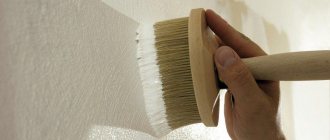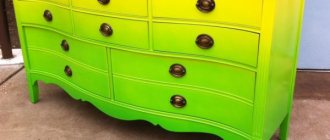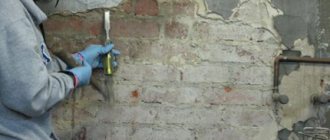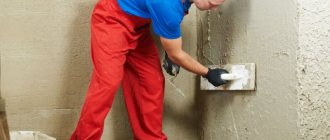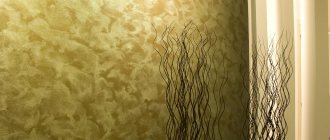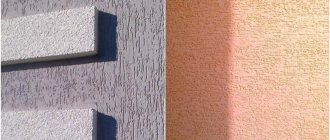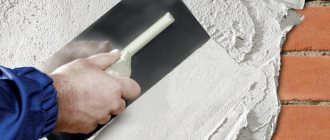Fiberglass is a building material that is one of the best options for high-quality and durable interior decoration. With its help you can avoid cracks on the surface of walls and ceilings.
What does fiberglass look like?
However, this material is not a finishing type coating. Today we will look into the questions: is it possible to paint fiberglass without putty and will tell you which paints are best to use for the job.
Area of application of the material
What it is? Fiberglass is a non-woven fabric obtained by pressing and consisting of the smallest glass fibers. This is a thin translucent material, therefore, in professional jargon, painting fiberglass is often called gossamer.
Why do you need painting fiberglass? It guarantees the avoidance of visible damage to walls and ceilings. The appearance of cracks on surfaces covered with plaster and putty is not always associated with the unprofessionalism of the workers who carried out the repairs. Cracking is caused by the physical properties of traditional building materials, which shrink over time when exposed to dry air.
Another reason for the appearance of cracks is constant vibration, which is typical for houses located next to a highway or railroad. Due to the appearance of cracks, previously it was necessary to frequently renew the decorative coating.
The use of fiberglass allows you to obtain perfectly smooth, durable and crack-resistant walls and ceilings.
Hypoallergenicity, fire safety, ease of use, durability and the ability to transmit water vapor, thanks to which the decorated surfaces have optimal humidity, determine the increasingly frequent use of gossamer for reinforcing walls and ceilings.
Description of finishing material
Fiberglass threads are woven on a machine, pressed, and at the finish fiberglass is produced in the form of a smooth and even sheet, its density is 25-50 grams. per 1 m 2. It is endowed with water resistance, vapor and air permeability, resistance to chemicals, dust-repellent properties, and prevents mold. Gluing fiberglass is an opportunity to quickly prepare the surface for painting. In terms of its technological properties, the material is similar to glass wallpaper, but there is no texture. Thanks to this, paint for fiberglass is applied to its surface many times.
Specifications
Painting fiberglass is a lightweight fibrous material obtained from natural raw materials, which is quartz sand.
Fiberglass web is supplied in rolls, the length of the canvas is 50 m, width 1 m.
The density of fiberglass varies from 25 to 50 g/m2.
Samples of different densities
It is better to choose fiberglass of higher density for walls, and lower density for ceilings.
The material can be used at temperatures from – 40 to + 60 ° C, which makes it suitable for any climatic conditions.
The web is breathable and hygienic: it does not electrify, does not accumulate dust, can withstand wet cleaning, and does not form mold or mildew. The material does not emit harmful substances into the air and does not support combustion. All this, coupled with resistance to mechanical damage and the possibility of quick application, gives the web an advantage over other types of finishing materials.
Main features of choosing fiberglass
To carry out work at the highest level, you should not skimp on materials and purchase low-quality products:
- As practice has shown, the optimal density of fiberglass in terms of price-quality ratio is 45-55 g/m2. It is sold in rolls 1 meter wide and 50 meters long. Some retail outlets may cut off the amount you need, sometimes 50 meters is too much.
- To glue the material, you will need a special glue for glass wallpaper; it must be a high-quality composition, since the strength of the entire surface depends on it. And one more nuance: the glue consumption when gluing “cobwebs” is at least one and a half times greater than that of glass wallpaper due to the specific application and absorbency of the material.
There will be quite a lot of adhesive composition, so you should stock up thoroughly
- It is also worth purchasing a smoothing spatula for wallpaper - with its help you will level the material and expel the air from under it.
- Another important element is a construction knife, with which excess pieces will be removed.
Precautionary measures
Fiberglass web forms a hard, wear-resistant coating on the wall that can be washed, but it acquires these qualities only in combination with glue. Before talking about how to glue fiberglass to walls, you should take precautions.
The material that has not yet been glued is quite fragile, and its small particles can get into the respiratory tract. Once on the skin and mucous membranes, glass fibers cause irritation, so when working, be sure to use a respirator, safety glasses and protective clothing.
You can glue cobwebs only at a certain temperature (from + 15 to + 25 ° C) and air humidity of no more than 60%. During work, drafts are not allowed; direct sunlight must be avoided.
Fiberglass in a roll
How to properly glue fiberglass? It is necessary that the walls are pre-leveled and puttied. Before gluing fiberglass to plasterboard, you need to carefully putty and reinforce the seams between the slabs and then ensure that they do not coincide with the boundaries of the glass panels. Fiberglass canvas is glued to putty only after using a deep penetration primer, which will avoid overuse of adhesive.
The technology assumes that the web can be glued only with special compounds that do not contain starch, for example, Bostik, Oscar, Wellton adhesives produced by fiberglass manufacturers. Glass wallpaper is also glued with the same compounds.
It should be taken into account that the material has a reverse side and a smoother front side: it is important not to confuse it.
Applying paint to fiberglass
Preparation
Most often, home craftsmen are interested in: does fiberglass need to be puttied before painting? This procedure is not necessarily necessary, but highly desirable.
The fact is that fiberglass is far from perfectly smooth. In addition, there are necessarily joints between the canvases, which can become quite noticeable after the glue dries.
Puttying the wall
Putty will eliminate all these defects and make the surface truly ideal. As a rule, it is applied in 2-3 layers, each no more than one millimeter thick. To apply the last layer, a finishing putty is used, which ensures the best smoothness.
After filling, the surface must be sanded with fine sandpaper, thereby eliminating even the slightest flaws on the surface. To make sure that the fiberglass is prepared for painting, you should point a flashlight or spotlight at the treated surface. A beam of light will reveal all existing flaws.
Tools and consumables
To paint fiberglass, you need to prepare the following tool:
- Roller with tray or spray bottle for applying paint;
- Brush for painting hard-to-reach places;
- Masking tape and oilcloth.
Roller with tray
Painting
After the base is leveled, the fiberglass canvas is directly painted. True, it is first necessary to treat the surface with a primer composition. This will improve paint adhesion and also reduce its consumption.
Instructions for applying the paint coating are as follows:
- Before you start painting, you need to protect the surfaces that will not be painted from contamination. You can use masking tape for this. The floor should be covered with oilcloth.
- Next, you need to thoroughly mix the coloring composition to eliminate its heterogeneity. If necessary, you need to add a certain amount of color to the paint. To determine the proportions, you can pre-mix the components in a small volume.
- Then you need to pour the paint into the pan and dip the roller into it. Before applying the coating, the tool should be wrung out on a special platform in the tray. Painting is done from top to bottom, in an even layer.
- After the first layer has dried, to achieve maximum quality of the coating, the procedure must be repeated again.
- At the end of the work, you need to touch up hard-to-reach places with a brush.
Mixing paint with color
At this point the work is completed, all that remains is to wait for the paint to dry completely, after which the walls can be used.
Rules for gluing
The material should be glued as follows:
- cut the material into strips according to the height of the walls with an allowance of up to 10 cm;
- according to the instructions, prepare a solution from a dry substance - the preparation time should not exceed 15 minutes (a ready-made solution is also sold, but it is much more expensive);
- Apply glue evenly without gaps to the wall or ceiling - you need to cover with glue an area slightly larger than the width of the first canvas;
- strictly vertically, pressing with a roller or flexible plastic spatula, glue the first canvas - pasting begins from the corner closest to the window, the canvas is positioned end-to-end;
- apply the next portion of glue and attach the second canvas overlapping - for the paint to look even, the pile on the canvases should be directed in one direction;
- use a stationery knife to cut off the excess under the ceiling, above the floor and exactly along the joint (to make it smooth, it is convenient to press a wide spatula to the borders and cut along its edge);
- Cover the glued canvases with glue on top - you need to stop when the color becomes uniform.
Then the steps are repeated. Anyone who has at least once glued fiberglass under putty knows that it takes significantly less time than gluing wallpaper.
The video will show you how to glue fiberglass sheets to the ceiling.
It is important that the room remains closed until the glue has completely dried. A draft can completely destroy the results of the work, causing the paintings to peel off.
conclusions
As you can see, gluing fiberglass, painting and puttying the surface between these two processes is the only suitable option for obtaining not only a durable, but also a smooth and attractive-looking wall. At the same time, the work does not require much more time than the usual finishing of enclosing structures, and the result is noticeably different for the better. The reasons for choosing the option without wall putty can only be the need to save money with a limited budget and low requirements for the quality of painting, since an attempt to obtain a high-quality result in this case will lead, on the contrary, to overspending on paint and loss of quality.
Source
How to prepare fiberglass for painting
Craftsmen are often interested in questions: is it necessary to prime fiberglass, and is it necessary to putty fiberglass and why is this done? There is no need to prime the coating before puttying or painting, because the walls have already been primed before gluing it on. In addition, the glue acts as a primer.
The question of whether puttying is necessary does not have a clear answer. Fiberglass has a beautiful texture, which is sometimes preferable to preserve, but the paint consumption will be very high and at least 4-5 layers will be required. Paint will make the joints noticeable: even if they are made perfectly, their mere presence will not at all decorate the room. It is better to putty fiberglass before painting for another reason: small fibers can get into the air, which is harmful to health, and putty completely prevents their penetration.
What to putty on? There is no special putty for fiberglass; you can use any finishing mixture based on gypsum or polymer, as long as it is of good quality.
How to putty painting fiberglass? The technology has some features:
- by the time the putty is applied, the glue must be completely dry;
- if the coating was pasted several days ago, it needs to be cleaned of dust;
- the adjacent surface is protected with masking tape;
- putty is applied in two layers with an interval of 24 hours;
- the thickness of the first layer should not exceed 2 mm;
- the second layer should be just as thin and completely cover the first;
- After drying, the putty is sanded using a block of sandpaper with a grain size of no more than P150.
Fiberglass putty allows you to get a perfectly flat, durable surface.
Do I need to putty before painting?
One of the main advantages of using fiberglass is the ability to almost immediately stick wallpaper or apply paint on it. This raises the question: is it possible to paint fiberglass without putty or is it still needed? In the first case, you can save time on drying the material leveling the walls, in the second, the quality of the finish improves.
Even professional builders disagree on whether it is necessary to putty fiberglass before painting, but most of them advocate the use of putty for the following reasons:
- Due to its high absorbency, the material will have to be painted in several layers - usually from 2 to 5 times. In this case, a huge amount of paint will be consumed and much more time will be spent than would be saved by not using putty.
- The texture of fiberglass is noticeable even under 1-2 layers of paint. As a result, painting fiberglass without putty can ruin the interior of the room. The pores of the material are very difficult to paint over and appear again after applying the next layer of paint. And only putty will help eliminate this drawback.
- When painting fiberglass, especially those located on the ceiling, a lot of small fibers fall on the person doing the work. And, rising into the air, they can end up inside the respiratory organs. Painting a putty surface is not only easier, but also safer.
- If after renovation it was decided to replace the paint on the walls with wallpaper, it is almost impossible to do this on an unputtyed surface.
Considering these disadvantages, it can be noted that it is undesirable to paint fiberglass without putty - except in cases where a flat and smooth surface in a room (for example, a household or utility room) is not very necessary. However, using this material, even taking into account additional work, is still more profitable and convenient than immediately puttingtying ceilings and walls, skipping the stage of working with canvas. In the future, surfaces protected by it will last longer, and the likelihood of cracks appearing is almost zero.
Painting fiberglass
How to paint fiberglass? If you decide to paint fiberglass without prior puttying, you will not need to prime it, but its texture will be visible even under many layers of paint. Still, painted walls or ceilings will have a more attractive appearance if they have been previously puttied; in this case, you need to apply a primer. To paint walls, it is better to choose water-based paints that adhere well and are easy to work with.
Applying paint
Fiberglass is painted using the same technology as other materials.
The paint is applied with a roller until there are no areas of uneven tone left on the painted surface.
Is it possible to glue wallpaper onto fiberglass? Yes, because this material is not a finishing material. Fiberglass for wallpaper is a common finishing option, but before final finishing the surfaces need to be puttied and primed.
Fiberglass is rarely used as a decorative covering, but it is irreplaceable as a reinforcing material. Its use will allow you to achieve a perfectly smooth surface, and cosmetic repairs will not be required for much longer.
Paint selection
So, having understood the features of fiberglass, we can come to the conclusion that the same paint and varnish coatings are used for its finishing as for glass wallpaper. Experts recommend choosing water-dispersion paints, since they do not change the properties of the canvas, which is the most important point when choosing.
In addition, such paints are absolutely harmless to the human body and odorless, as they are based on water and polymers. Therefore, they can be used even in rooms such as bedrooms and children's rooms.
Most often, to paint walls with your own hands, the following types of water-dispersed paints are used:
- Acrylic;
- Latex;
- Silicone.
Now let's take a closer look at the features of these coatings.
Acrylic paint
Acrylic
Acrylic compositions are perhaps the most popular.
Among their main characteristics the following points can be highlighted:
- Dries quickly;
- Not afraid of moisture;
- Have good adhesion;
- Affordable price for material;
- As a rule, the paint is white, so you can add colors and thereby get almost any shade.
Advice! To maintain the fire safety of the coating, fire retardant water-dispersion paints should be used. True, for reliable fire protection of a room, it is necessary to cover not only the walls with such compounds, but also the ceiling, as well as metal communications; for the latter, you can use fire-retardant metal paints Polistil.
Latex paint
Latex
Latex paints are slightly more expensive than acrylic paints, however, their performance properties are slightly higher.
In particular, they differ:
- Increased wear resistance;
- Moisture resistance;
- Durability;
- Unlike acrylic coatings, they can form a glossy surface.
Silicone paint
Silicone
This type of paint is the most expensive, however, it includes all the positive aspects of both of the above compositions, without having their disadvantages. In addition, silicone paints are distinguished by the fact that they have dirt-repellent properties, so the walls will have to be washed much less often.
Recommendations for home crafters
In the process of decorating fiberglass, it is necessary to simultaneously paint the plumbing and heating systems. Communication pipes are often made of metal. Therefore, a composition with anti-corrosion properties is needed. For example, the electrically conductive Zinga CM is recommended.
It is recommended to strengthen the fixation of the canvas after gluing. The glue is diluted to a more liquid state. A mass of this consistency is applied on top of the canvas so that the sheet is saturated.
To the question whether it is possible to paint fiberglass without putty, the answer is yes, it is possible, but it is not recommended to ignore the preparatory work. It will take more paint and time to dry. Putty hides the texture of the canvas, which even 2 layers of dye cannot do. Puttying and priming the canvas is necessary. The strength of the entire foundation depends on this. The process is cheaper than simply plastering the walls and ceiling without working with fiberglass along with additional work. Leveling the surface with putty may not be necessary if a perfectly smooth coating is not needed. For example, in the back room, in the warehouse.
To glue fiberglass, you can use glue for glass wallpaper. They contain components that prevent the appearance of fungus. Dry glue is diluted strictly according to the instructions. Recommended adhesives: Bostik (Sweden), Wellton (Ukraine), Oscar (Ukraine), Pufas (Germany).
Latex paint creates a glossy finish.

